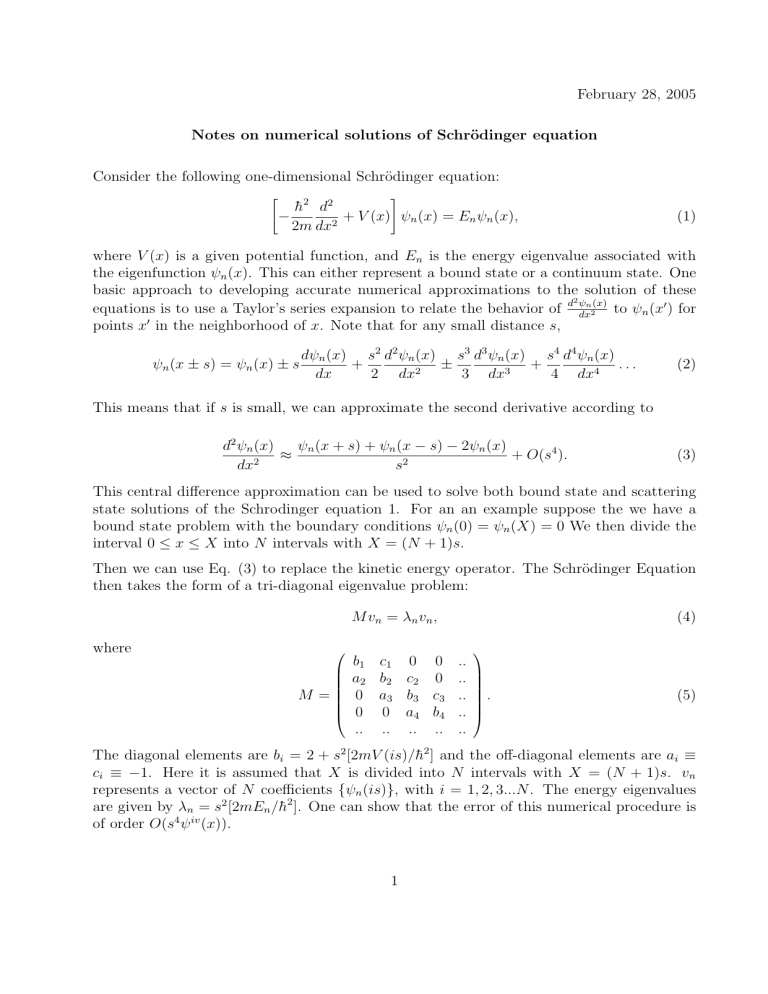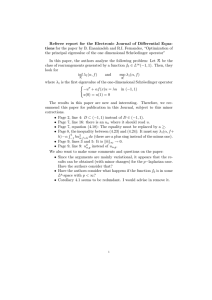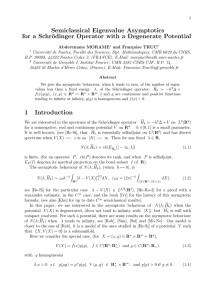February 28, 2005 Notes on numerical solutions of Schr¨ odinger equation
advertisement

February 28, 2005
Notes on numerical solutions of Schrödinger equation
Consider the following one-dimensional Schrödinger equation:
"
h̄2 d2
−
+ V (x) ψn (x) = En ψn (x),
2m dx2
#
(1)
where V (x) is a given potential function, and En is the energy eigenvalue associated with
the eigenfunction ψn (x). This can either represent a bound state or a continuum state. One
basic approach to developing accurate numerical approximations to the solution of these
2
equations is to use a Taylor’s series expansion to relate the behavior of d ψdxn2(x) to ψn (x0 ) for
points x0 in the neighborhood of x. Note that for any small distance s,
dψn (x) s2 d2 ψn (x) s3 d3 ψn (x) s4 d4 ψn (x)
ψn (x ± s) = ψn (x) ± s
+
±
+
...
dx
2 dx2
3 dx3
4 dx4
(2)
This means that if s is small, we can approximate the second derivative according to
d2 ψn (x)
ψn (x + s) + ψn (x − s) − 2ψn (x)
≈
+ O(s4 ).
2
dx
s2
(3)
This central difference approximation can be used to solve both bound state and scattering
state solutions of the Schrodinger equation 1. For an an example suppose the we have a
bound state problem with the boundary conditions ψn (0) = ψn (X) = 0 We then divide the
interval 0 ≤ x ≤ X into N intervals with X = (N + 1)s.
Then we can use Eq. (3) to replace the kinetic energy operator. The Schrödinger Equation
then takes the form of a tri-diagonal eigenvalue problem:
M vn = λn v n ,
where
M =
b1 c 1 0 0
a2 b 2 c 2 0
0 a3 b 3 c 3
0 0 a4 b 4
.. .. .. ..
(4)
..
..
..
..
..
.
(5)
The diagonal elements are bi = 2 + s2 [2mV (is)/h̄2 ] and the off-diagonal elements are ai ≡
ci ≡ −1. Here it is assumed that X is divided into N intervals with X = (N + 1)s. vn
represents a vector of N coefficients {ψn (is)}, with i = 1, 2, 3...N . The energy eigenvalues
are given by λn = s2 [2mEn /h̄2 ]. One can show that the error of this numerical procedure is
of order O(s4 ψ iv (x)).
1
By keeping the next even term in the Taylor series expansion, one can derive a Numerov
algorithm for this problem which takes the form:
M vn = λn Svn .
(6)
Here M is a tridiagonal matrix having the same form as above, and S is a positive definite
tridiagonal matrix having the form:
S=
β1 γ1 0 0
α2 β2 γ2 0
0 α3 β3 γ3
0 0 α4 β4
.. .. .. ..
..
..
..
..
..
.
(7)
10 2
In this expression, βi ≡ 10/12 and αi ≡ γi ≡ 1/12, while bi ≡ 2 + 12
s [2mV (is)/h̄2 ],
1 2
1 2
ai ≡ −1 + 12
s [2mV ((i − 1)s)/h̄2 ], and ci ≡ −1 + 12
s [2mV ((i + 1)s)/h̄2 ]. One can show
that the error of this numerical procedure is of order O(s6 ψ vi (x)).
2






